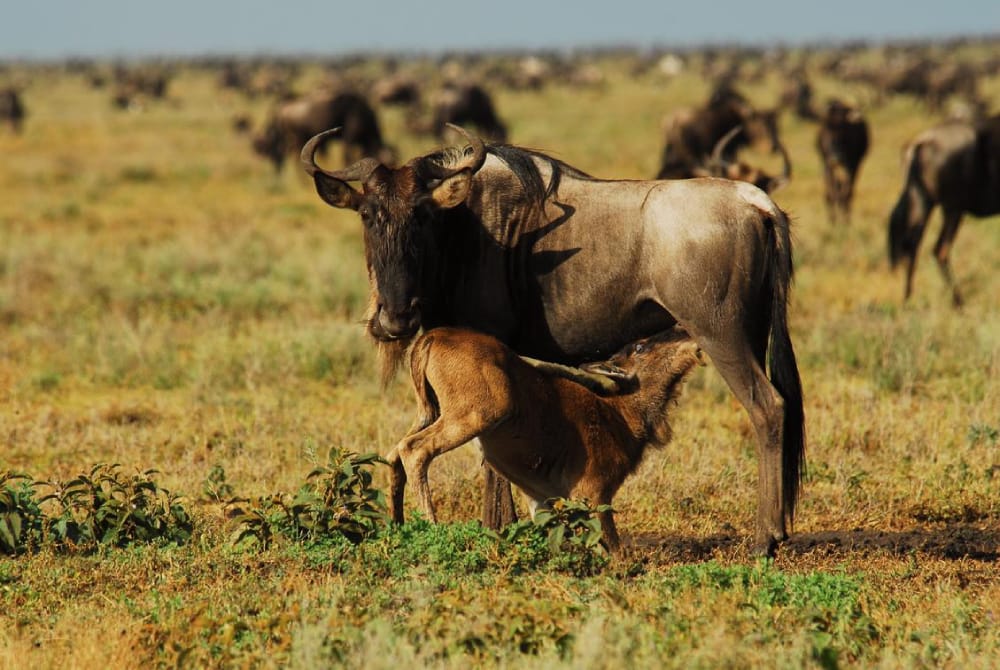
The climate is tropical on the coast, on the islands and in Selous. It is temperate in the other parks. Temperatures on Mount Kilimanjaro and Meru drop to below freezing. Late March – late May is traditionally the long rainy season and is considered the “winter period” in Tanzania.
June – late October is the dry season. June, July and August can be very cold on the rim of Ngorongoro Crater. Mnemba Island is lovely at this time of year, the evenings are cool (not cold) and the daytime can be hot. Late October – mid December is when the short rains occur. These are usually in the form of daily thunderstorms.
The Ngorongoro Crater rim has a wonderful climate at this time of year. The Serengeti and Lake Manyara are quite warm and Mnemba is very hot. Mid December – March is summer weather. It is dry and very warm until March. Due to its altitude Ngorongoro Crater is much cooler than elsewhere.
ENVIRONMENT:
A land of plains, lakes and mountains with a narrow, low-lying coastal belt, Tanzania is East Africa’s largest country. The bulk of the country is a highland plateau, some of it semi-desert and the rest savannah and scattered bush. The highest mountains – Meru (4, 556m/14, 943ft) and Kilimanjaro (Africa’s highest at 5, 895m/19, 335ft) – are in the north-east along the border with Kenya.
Nowhere else on earth will you see wildebeest, gazelle, zebra and antelope in such enormous numbers – and Tanzania’s characteristic plains make spotting wildlife easy. Blessed with some of the world’s largest game reserves, the country also has one of the highest concentrations of elephant, buffalo, crocodile, hippo, hunting dog and chimpanzee.
Tanzania’s widely varying geography accounts for its differing climatic conditions. The altitude of the high plateau considerably tempers what would otherwise be a tropical climate. In many places it can be quite cool at night.
The coastal strip along the Indian Ocean and the offshore islands of Pemba, Zanzibar and Mfia have a hot, humid, tropical climate alleviated by sea breezes. Only on the mountain slopes of the north-east does the country enjoy an almost temperate climate for most of the year. Tanzania offers unparallel game viewing opportunities all year round – even during the rainy seasons of April to May, and November. For the budget-conscience travellers who don’t mind a little rain, the low seasons may be the perfect safari opportunity.)
WHEN TO GO:
Tanzania offers an astonishing diversity and concentration of wildlife, from the immense Serengeti and towering Mount Kilimanjaro to the remote national parks of Katavi and Mahale. The best months for climbing Mount Kilimanjaro are August to October and January to March.
Tanzania boasts over 1, 000 bird species, with Lake Manyara alone being home to more than 400. It is a year round birding destination, but at the height of the northern winter, some 160 species of migrating birds make their way south. Botanically, Tanzania is a treasure-trove, with habitats ranging from Afro-Alpine to semi-desert. The months immediately after the two rainy seasons provide the best floral displays.
WILDEBEEST MIGRATION:
The wildebeest migration takes place within Kenya and Tanzania and is one of the greatest wildlife shows on earth. Between the open plains of the Serengeti and the Masai Mara, thousands of wildebeest and zebras migrate to greener pastures as the seasons change. The precise timing of the Wildebeest Migration changes annually and it is a very unpredictable and spontaneous natural event.
The calving season takes place in the Serengeti between the months of January and mid-March before the Wildebeest Migration begins heading towards the Western Serengeti in June. The best time to see the migration is usually between June and August when the wildebeest congregate and prepare to cross the famous Grumeti River.
If you are in the Masai Mara you can expect the wildebeest to make their arrival as early as July, but they generally arrive between August and September and remain in the Mara between October and November.
Between December and January the wildebeest gradually begin their migration back towards the Serengeti. As this is a natural phenomenon, the monthly migration patterns can change from year to year and this is to be used as a general guide.
Tanzania offers excellent game viewing throughout the year as not all animals migrate and are year-round residents.